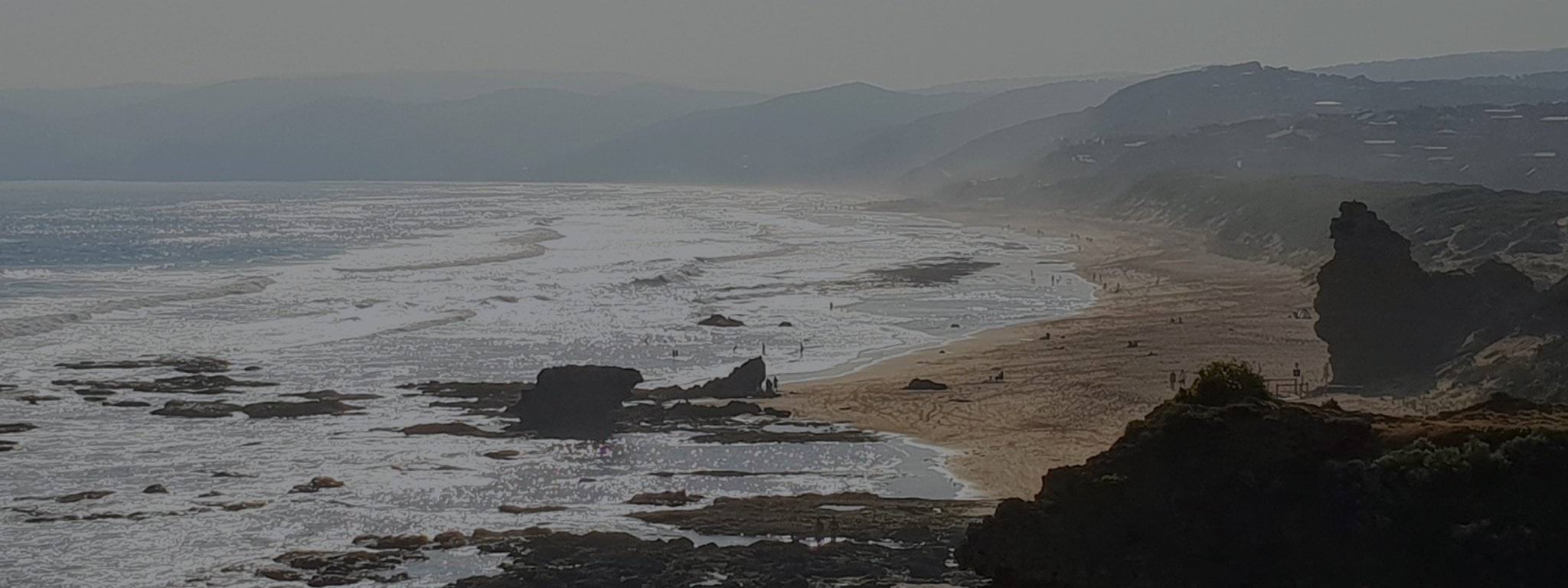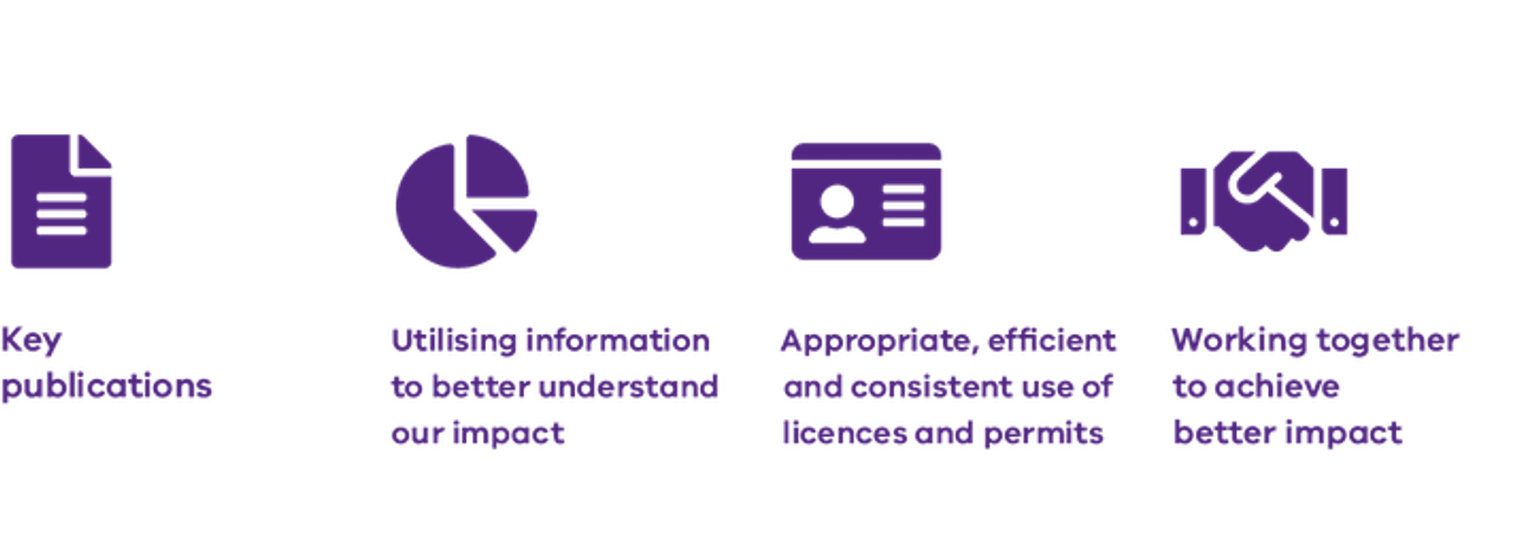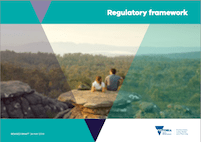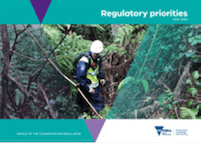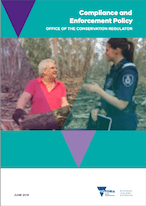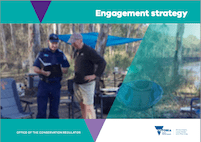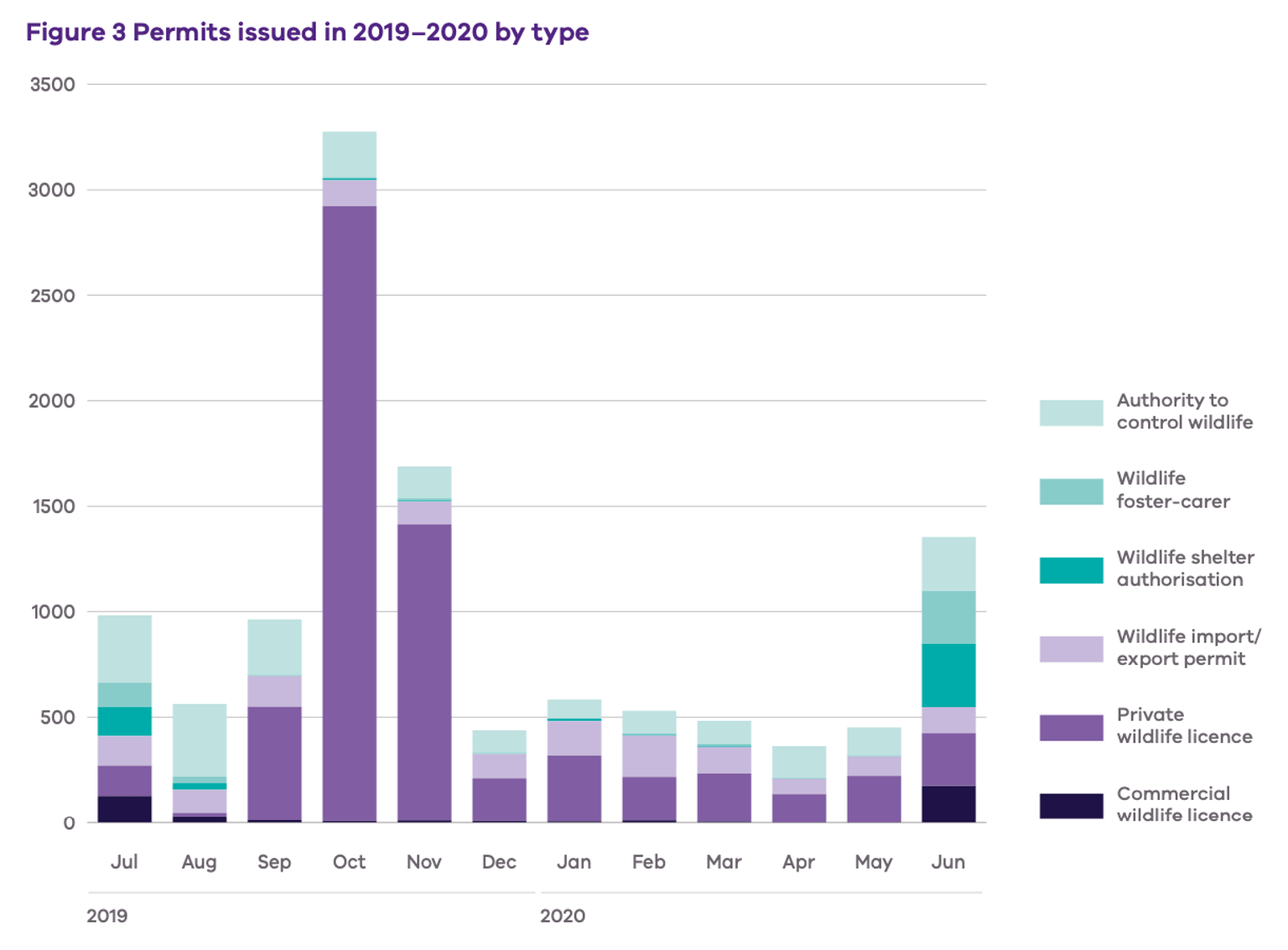In our first year of operation, we have made significant progress in establishing ourselves as a new regulator. We have lifted the regulatory performance of DELWP, delivering better regulatory outcomes while driving a more open and transparent approach. We have also adopted a more strategic approach to our work, one that focuses our efforts on where the greatest risks lie, and where we can have the most impact. Listed are some of our key initiatives and projects implemented in 2019–2020.
Key publications
The following publications were published since the commencement of the Conservation Regulator in early 2019. These publications communicate our priorities, mission, values and ways-of-working.
DELWP Regulatory Framework
Outlines how DELWP will undertake its regulatory responsibilities and the principles which will guide our approach.
Regulatory Priorities 2019-2020
Presents our first public Annual Regulatory Priorities which outlines the state-wide priorities and recognises the unique context and compliance risks facing the Victorian regions.
Compliance and Enforcement Policy
Describes how the Conservation Regulator will apply the law and exercise judgement and discretion in our compliance and enforcement.
Engagement Strategy
Describes how we will engage with the community, stakeholders, Traditional Owners and co-regulators to deliver regulatory outcomes for the environment and the Victorian community.
Utilising information to better understand our impact
Using the best-available information is essential for us to target our resources to where the greatest risks lie, and to where they will have the most impact. To support this, we have developed:
Monitoring Evaluation and Reporting Framework
To provide accountability and validity of the effectiveness and efficiency of specific regulatory interventions.
Three-year Strategic Intelligence Plan
To better identify and understand how risks and harms to our environment are allowing us to better target our effort to where it will be most effective.
Appropriate, efficient and consistent use of licences and permits
There are many reasons people in our community may need, or want, to interact with native flora and fauna. Some people may wish to keep certain species as pets or for farming, others may need to remove wildlife from their property where they are causing safety or commercial problems.
In circumstances such as these, licences and permits can be granted to allow activity that would otherwise be illegal. Regulatory permissions (licences, permits and authorities) are used to selectively grant permission to conduct an activity which is otherwise illegal.
The Conservation Regulator assesses and decides whether to grant or refuse permissions applications. We also play a role in determining compliance monitoring programs, by assessing compliance levels, and responding to non-compliance.
In 2019–2020, the Conservation Regulator processed more than 11,000 licences and permits. Figure 3 and Table 1 outline the types and volumes of wildlife licences, permits and authorities issued in 2019–2020.
Different permissions types
There are many different permissions relating to environmental conservation in Victoria. They all help to make sure when people do interact with native species, they do it carefully, responsibly and sustainably.
Permissions that the Conservation Regulator is responsible for include:
- Private wildlife licences allow people to keep wildlife as pets.
- Commercial wildlife licences allow for the commercial use of wildlife, including selling wildlife in pet shops, keeping wildlife in zoos, as well as taxidermy and other processing of wildlife products.
- Authorities to control wildlife are for landholders and land managers who have issues with wildlife causing damage to buildings, pasture, crops or other property, or which pose risks to human health and safety. An authority may include permission for lethal or non-lethal control methods.
- Forest produce licences allow individuals and private companies to cut, dig and take away material from state forests for personal or commercial use.
- Research Permits are required for all wildlife in any research capacity, for instance, attaching radio collars to track wildlife, or taking samples from wildlife to better understand genetics.
- Wildlife foster carer licences are required for the care and rehabilitation of injured and orphaned wildlife
Table 1: Total number of licences in 2019-2020
| Licence type | Number |
|---|---|
|
Commercial wildlife licence |
390 |
|
Private wildlife licence |
6580 |
|
Wildlife import/export permit |
1512 |
|
Wildlife shelter authorisation |
505 |
|
Wildlife foster-carer |
449 |
|
Authority to control wildlife |
1990 |
Reforming regulatory permissions
The Conservation Regulator is committed to reforming our licensing and permit systems to make them more efficient, user-friendly and consistent.
In mid-2019, we established a new organisational structure which provides specific resources in each region to support both the efficient processing of permissions, and greater consistency in how permissions are assessed and monitored.
The priority of our permissions reform program is Authorities to Control Wildlife (ATCW). We have been building on the 2019 review of the ATCW system by DELWP’s Biodiversity Division, to guide ATCW reforms.
Work commenced to support the online submission of ATCW applications, and this is expected to go online in 2020–2021.
To support greater consistency across the state in how ATCW applications are assessed, we have improved training and assessment guidelines for assessing officers.
Improved guidance for applicants, along with smoother applications and assessment processes is planned for 2020–2021.
Improvements have also been made to other types of regulatory permissions, including moving from exclusively paper-based to electronic applications and renewals for wildlife licences.
Working together to achieve better impact
Being a successful regulator requires strong relationships with a diverse range of stakeholders from community, industry and our regulatory partners.
The Conservation Regulator published its Engagement Strategy in July 2019 which describes how we will engage with community, stakeholders, Traditional Owners and co-regulators to deliver on our regulatory mission.
We established our Stakeholder Reference Group which meets quarterly and provides advice to the Chief Conservation Regulator on drivers, effective interventions and opportunities.
Partnering with our co-regulators has been a priority to ensure a complementary and coordinated approach to common regulatory risks.
The Conservation Regulator has worked closely with Parks Victoria, the Game Management Authority and Victoria Police throughout the year.
To minimise the impacts to koalas from blue-gum operations, engagement regarding the regulatory approach of koalas in blue gum plantations was undertaken, the outcomes of which will be released in 2020–2021.
We committed to further engagement activities in 2019–2020, however due to COVID-19, some of the face to face engagement activities and education programs planned have been delayed. These activities will be reassessed following the easing of COVID-19 restrictions.
Updated
